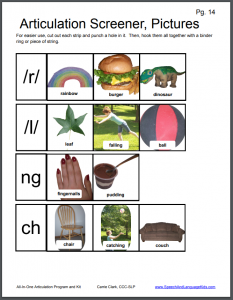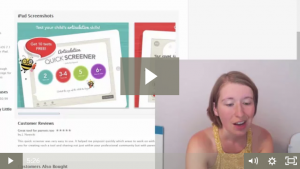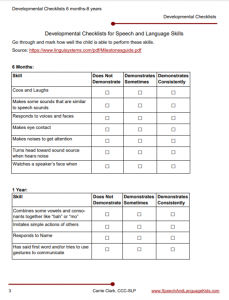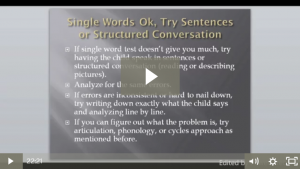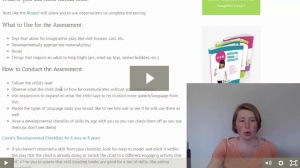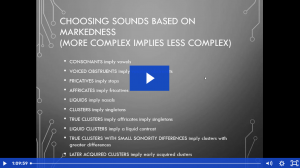Condition: Articulation Disorder
Jump To:
Norms by Age Evaluation Therapy Suggested Goals
Definition:
The term articulation disorder is used to describe when a child has errors on individual speech sounds. These errors may be substitutions, omissions, distortions, or additions. These errors are specific to individual sounds as opposed to in a phonological disorder when the child has rule-based errors that affect an entire class of sounds.
Developmental Norms:
Speech Sound Norms:
The following ages represent that ages by which each sound was mastered by 75% of children (based on two studies, see source below).
- 2-3 Years: /m/, /n/, /h/, /p/,
- 2-4 Years: /f/, “y”, /k/, /g/, /d/
- 2-8 Years: /w/, /b/, /t/,
- 3-4 Years: /s/, /r/
- 3-6 Years: /l/
- 3-8 Years: “ch”, “sh”
- 4-6 Years: /v/, voiceless “th”
- 4-7 Years: /z/, “zh”, “j”, voiced “th”
Intelligibility Norms:
Coplan and Gleason (1988) developed a standardized intelligibility screener using parent estimates of how intelligible their child sounded to others. On the basis of the data, expected intelligibility cutoff values for typically developing children were as follows:
(Source: https://www.asha.org/PRPSpecificTopic.aspx?folderid=8589935321§ion=Assessment)
- 22 months—50%
- 37 months—75%
- 47 months—100%
Evaluation:
If you suspect an articulation disorder, a full communication evaluation should be conducted. A full medical history and background should be collected and all areas of communication should be considered in the evaluation. Here are some additional resources that will help you with various aspects of evaluating this condition:
A simple, printable articulation screener that can be used to determine what sounds a child is having trouble with. Great for choosing a sound to start with for articulation therapy.
A quick video where Carrie reviews other articulation screeners that you may be interested in.
General developmental checklists for ages 6 mos-8 yrs. Includes which speech sounds should be mastered by each age.
How to Evaluate (and Treat) Highly Unintelligible Children – Webinar Recording
This hour-long webinar recording will walk you through how to evaluate and treat a child who is highly unintelligible.
Have a child who can’t sit down for standardized assessments? Find out here how to conduct a play-based assessment instead.
Complexity Approach to Articulation and Phonology: Teaching the Harder Sounds First
The complexity approach states that we should target harder sounds in speech therapy as we may then see spontaneous progress on easier sounds. Watch this hour-long webinar to learn more.
Therapy and Suggested Goals:
Click on an approach to learn more about when it is used and what goals you should target.
The Van Riper approach is often considered the traditional approach for treating specific articulation speech sound errors. This approach will allow you to work on one sound at a time. This approach begins by treating the sound in isolation and then moves up through the following phases of therapy for each sound: syllables, single words, short phrases, sentences, structured conversation, unstructured conversation/carry-over.
Who is This Approach For?
This approach is a great standard approach for a child with an articulation disorder without a lot of extra complicating factors. This is a great approach to start with for most children and can be modified as needed if a child does not make adequate progress.
More Information About the Traditional (Van Riper) Articulation Approach
Suggested Goals:
When choosing sounds to target with this approach, you can start with earlier-developing sounds (see the norms above) or you can use the complexity approach and start by treating harder sounds to see if the easier sounds will develop on their own.
- Produce the /b/ Sound (Print the No-Prep Kit)
- Produce the “ch” Sound (Print the No-Prep Kit)
- Produce the /d/ Sound (Print the No-Prep Kit)
- Produce the /f/ Sound (Print the No-Prep Kit)
- Produce the /g/ Sound (Print the No-Prep Kit)
- Produce the /h/ Sound (Print the No-Prep Kit)
- Produce the “j” Sound (Print the No-Prep Kit)
- Produce the /k/ Sound (Print the No-Prep Kit)
- Produce the /l/ Sound (Print the No-Prep Kit)
- Produce the /m/ Sound (Print the No-Prep Kit)
- Produce the /n/ Sound (Print the No-Prep Kit)
- Produce the “ng” Sound (Print the No-Prep Kit)
- Produce the /p/ Sound (Print the No-Prep Kit)
- Produce the /r/ Sound (Print the Mixed /r/ Kit)
(Print the Initial /r/ Kit)
(Print the “er” Sound Kit)
(Print the “ear” Sound Kit)
(Print the “ar” Sound Kit)
(Print the “ire” Sound Kit)
(Print the “air” Sound Kit)
(Print the “or” Sound Kit)
(Print the “rl” Sound Kit)
(Print the /r/ Blends Sound Kit) - Produce the /s/ Sound (Print the No-Prep Kit)
- Produce the “sh” Sound (Print the No-Prep Kit)
- Produce the /t/ Sound (Print the No-Prep Kit)
- Produce the Voiced “th” Sound (Print the No-Prep Kit)
- Produce the Unvoiced “th” Sound (Print the No-Prep Kit)
- Produce the /v/ Sound (Print the No-Prep Kit)
- Produce the /w/ Sound (Print the No-Prep Kit)
- Produce the “y” Sound (Print the No-Prep Kit)
- Produce the /z/ Sound (Print the No-Prep Kit)
- Produce Vowel Sounds (Print the “ay” Vowel Kit)
(Print the “a” Vowel Kit)
(Print the “ee” Vowel Kit)
(Print the “eh” Vowel Kit)
(Print the “igh” Vowel Kit)
(Print the “ih” Vowel Kit)
(Print the “oe” Vowel Kit) - Produce Sound Blends
- Produce Multi-Syllabic Words
- Carry-Over/Generalize Speech Sounds to Conversational Speech

